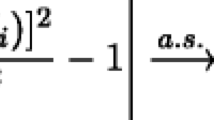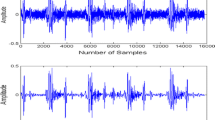Abstract
This paper addresses the problem of mother wavelet selection for wavelet signal processing in feature extraction and pattern recognition. The problem is formulated as an optimization criterion, where a wavelet library is defined using a set of parameters to find the best mother wavelet function. For estimating the fitness function, adopted to evaluate the performance of the wavelet function, analysis of variance is used. Genetic algorithm is exploited to optimize the determination of the best mother wavelet function. For experimental evaluation, solutions for best mother wavelet selection are evaluated on various biomedical signal classification problems, where the solutions of the proposed algorithm are assessed and compared with manual hit-and-trial methods. The results show that the solutions of automated mother wavelet selection algorithm are consistent with the manual selection of wavelet functions. The algorithm is found to be invariant to the type of signals used for classification.






Similar content being viewed by others
References
Ahuja N, Lertrattanapanich S, Bose NK (2005) Properties determining choice of mother wavelet. IEE Proc Vis Image Signal 152:659–664
Aminian K, Robert P, Jequier E, Schutz Y (1995) Estimation of speed and incline of walking using neural network. IEEE Trans Instrum Meas 44:743–746
Andrzejak RG, Lehnertz K, Mormann F, Rieke C, David P, Elger CE (2001) Indications of nonlinear deterministic and finite-dimensional structures in time series of brain electrical activity: dependence on recording region and brain state. Phys Rev 64:1–8
Arafat S, Skubic M (2008) Modelling fuzziness measures for best wavelet selection. IEEE Trans Fuzzy Syst 16:1259–1270
Burke S (2012) Analysis of variance, statistics and data analysis. http://cpdee.ufmg.br/~fcampelo/files/disciplinas/EEE933/2012-1/Referencias/Burke2001%20-%203-Analysis%20of%20Variance.pdf
Cervigó́n R (2011) Biomedical applications of discrete wavelet transform. In: Olkkonen H (ed) Discrete wavelet transforms-biomedical applications. InTech, Europe, pp 1–16
Gandhi TK, Panigrahi BK, Anand S (2011) A comparative study of wavelet families for EEG signal classification. Neurocomputing 74:3051–3057
Garg G, Singh V, Gupta JRP, Mittal AP (2010) Optimal algorithm for ECG denoising using discrete wavelet transforms. Int Conf Comput Intell Comput Res. doi:10.1109/ICCIC.2010.5705839
Garg G, Singh V, Gupta JRP, Mittal AP (2010) Identification of optimal wavelet-based algorithm for removal of power line interferences in ECG signals. Indian Int Conf Power Electron. doi:10.1109/IICPE.2011.5728090
Garg G, Singh V, Gupta JRP, Mittal AP, Chandra S (2011) Computer assisted automatic sleep scoring system using relative wavelet energy based neuro fuzzy model. WSEAS Trans Biol Biomed 8:12–24
Garg G, Suri S, Garg R, Singh V (2011) wavelet energy based neural fuzzy model for automatic motor imagery classification. Int J Comput Appl 28:1–7
Garg G, Singh V, Gupta JRP, Mittal AP (2011) Relative wavelet energy as a new feature extractor for sleep classification using EEG signals. Int J Biomed Signal Proc 2:75–79
Garg G, Singh V, Gupta JRP, Mittal AP (2012) Wrapper based wavelet feature optimization for EEG signals. Biomed Eng Lett 2:24–37
Genetic algorithm global optimization toolbox. MathWorks Documentation
Goldberg DE (2001) Genetic algorithms in search, optimization, and machine learning. Pearson Education Publication, New York
Kemp B, Zwinderman AH, Tuk B, Kamphuisen HAC, Oberyé JJL (2000) Analysis of a sleep-dependent neuronal feedback loop: the slow-wave microcontinuity of the EEG. IEEE Trans Biomed Eng 47:1185–1194
Li J, Jiang T, Grzybowski S, Cheng C (2010) Scale dependent wavelet selection for de-noising of partial discharge detection. IEEE Trans Dielectr Electr Insul 17:1705–1714
Mallat SG (1989) A theory for multi resolution signal decomposition: the wavelet representation. IEEE Trans Pattern Anal Mach Intell 11:674–693
Moody GB, Mark RG (2001) The impact of the MIT-BIH arrhythmia database. IEEE Eng Med Biol 20:45–50
Obitko M (1998) Crossover and mutation. http://www.obitko.com/tutorials/genetic-algorithms/crossover-mutation.php
One-way analysis of variance, statistics toolbox. MathWorks Documentation
Penzel T, Moody GB, Mark RG, Goldberger AL, Peter JH (2000) The apnea-ECG database. Comput Cardiol 27:255–258
Rafiee J, Tse PW, Harifi A, Sadeghi MH (2009) A novel technique for selecting mother wavelet function using an intelligent fault diagnosis system. Expert Syst Appl 36:4862–4875
Rajasekaran S, Pai GAV (2003) Neural networks, fuzzy logic, and genetic algorithms synthesis and applications. Prentice Hall, India
Silva J, Narayana SS (2009) Discriminative wavelet packet filter bank selection for pattern recognition. IEEE Trans Signal Proc 57:1796–1810
Unser M, Aldroubi A (1996) A review of wavelets in biomedical applications. Proc IEEE 84:626–638
Žorž GF, Kavšek G, Antolič ŽN, Jager F (2008) A comparison of various linear and non-linear signal processing techniques to separate uterine EMG records of term and pre-term delivery groups. Med Biol Eng Comput 46:911–922
Author information
Authors and Affiliations
Corresponding author
Appendices
Appendix 1
1.1 Dataset I
Data described in [3], which is publicly available, is used for epilepsy detection. The complete dataset consists of five sets (denoted A–E), each containing 100 single-channel electroencephalogram (EEG) signals of 23.6 s. Sets A and B have been taken from surface EEG recordings of five healthy volunteers with eyes open and closed, respectively. Signals in two sets have been measured in seizure-free intervals from five patients in the epileptogenic zone (D) and from the hippocampal formation of the opposite hemisphere of the brain (C). Set E contains seizure activity, selected from all recording sites exhibiting ictal activity. EEG signals from Set A and Set C representing normal and pre-ictal brain activities, respectively, are used for epilepsy detection. Instead of Set E, Set C is used for the application since in practical situation it is not viable to detect epilepsy at the time of seizure from the ictal activity EEG.
1.2 Dataset II
In this case, the sleep EEG dataset provided by physiobank [17] is used. The recordings were obtained from Caucasian males and females (21–35 years old) without any medication; they contain horizontal EOG, Fpz-Cz and Pz-Oz EEG, each sampled at 100 Hz. Sleep scoring is done using Fpz-Cz EEG signals, and the hypnogram is used as the target output for training and evaluating the performance of the classifier. The scoring is done in three classes, namely waking, REM sleep and NREM sleep.
1.3 Dataset III
Data contributed by Dr. Thomas Penzel of Phillips University, Marburg, Germany, for physionet bank are used for apnea detection using ECG signals [23]. The data consist of 70 records, divided into a learning set of 35 record and a test set of 35 records. The ECG signals are digitized at 100 samples per second, and the gain is 200 A/D units per mV. ECG signals of 10 s duration are used for this study.
1.4 Dataset IV
The ECG data collected from MIT-BIH arrhythmia database [20] are used for multi-class classification of different types of arrhythmia namely, normal sinus rhythm, right bundle branch block (RBBB), left bundle branch block (LBBB) and atrial fibrillation (AF). The recordings were digitized at 360 samples per second per channel with 11-bit resolution over a 10 mV range and gain of 200 A/D per unit mV. The ECG segments from MLII signals of records 101, 109, 212 and 202 are used for NSR, LBBB, RBBB and AF, respectively.
1.5 Dataset V
The electrohysterogram (EHG) records (uterine EMG records) included in the Term–Preterm ElectroHysteroGram Database obtained at the University Medical Centre Ljubljana, Department of Obstetrics and Gynecology, are used for classification of term–preterm deliveries using EHG signals [28]. The records were obtained during regular checkups either around the 22nd week of gestation or around the 32nd week of gestation. Each record is composed of three channels, recorded from four electrodes. The differences in the electrical potentials of the electrodes were recorded, producing three channels:
-
S1 = E2–E1 (first channel);
-
S2 = E2–E3 (second channel);
-
S3 = E4–E3 (third channel).
Each signal has been digitized at 20 samples per second per channel, and the gain is 13107 A/D units per mV. For classification purposes, signal S3 is used as the EHG signal without any filtering.
1.6 Dataset VI
The EMG data provided by Department of Neurology, Beth Israel Deaconess Medical Center, is used to classify between Healthy, Neuropathic and Myopathic EMG signals [16]. The data were recorded at 50 KHz and then down sampled to 4 KHz. During the recording process, two analog filters were used: a 20-Hz high-pass filter and a 5-KHz low-pass filter.
Appendix 2
See Table 4.
Rights and permissions
About this article
Cite this article
Garg, G. A signal invariant wavelet function selection algorithm. Med Biol Eng Comput 54, 629–642 (2016). https://doi.org/10.1007/s11517-015-1354-z
Received:
Accepted:
Published:
Issue Date:
DOI: https://doi.org/10.1007/s11517-015-1354-z




